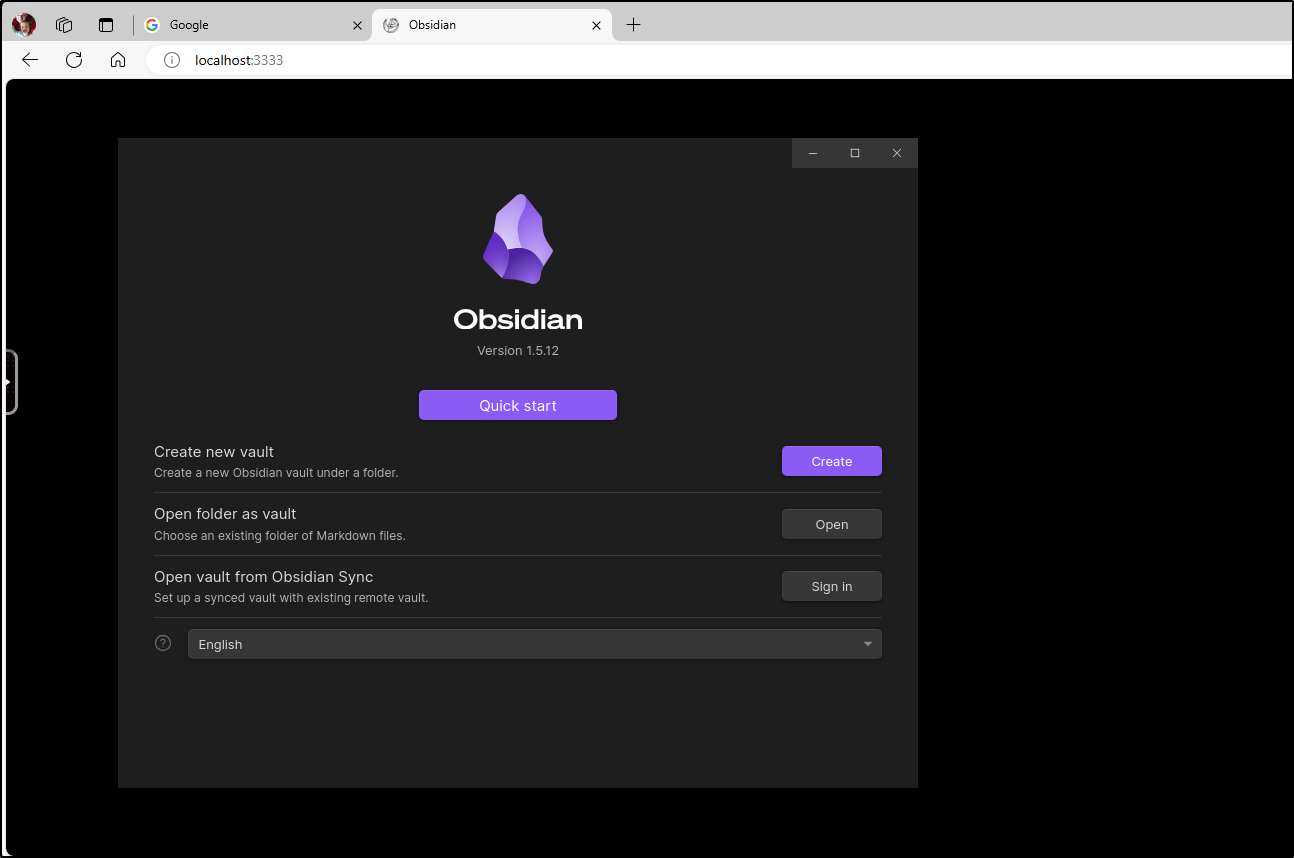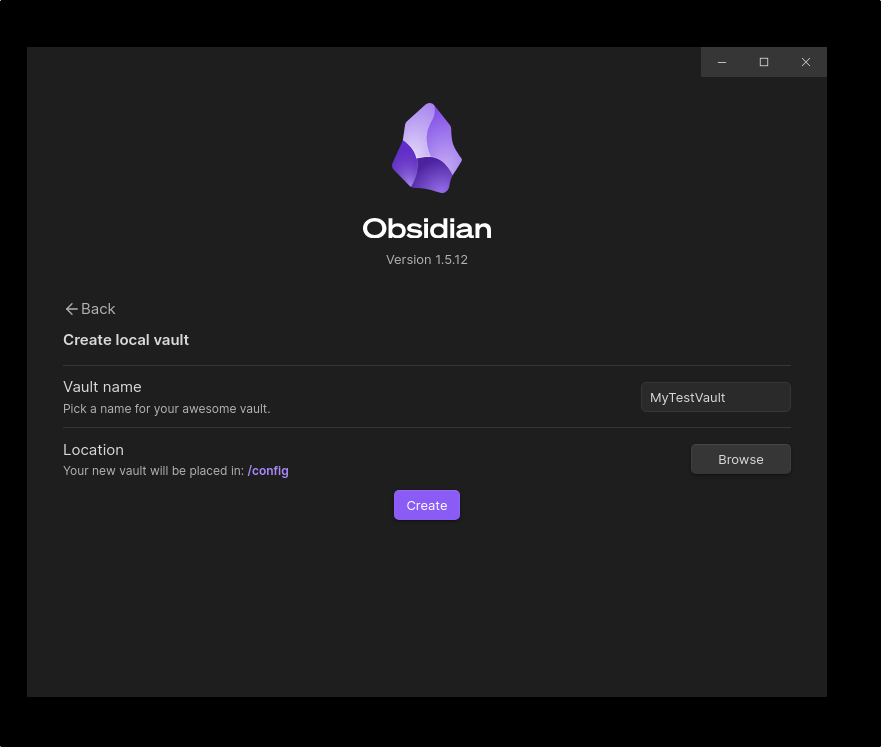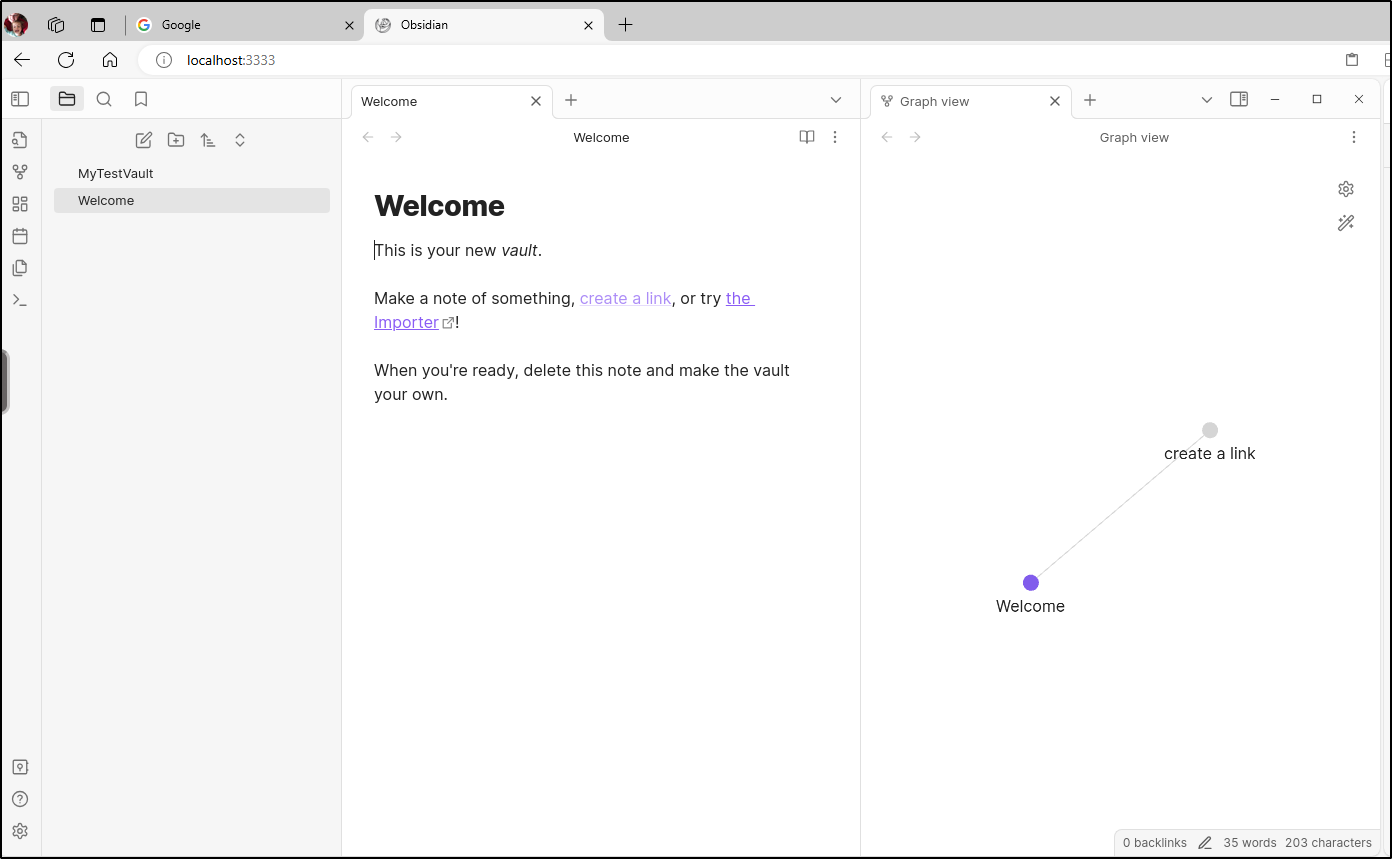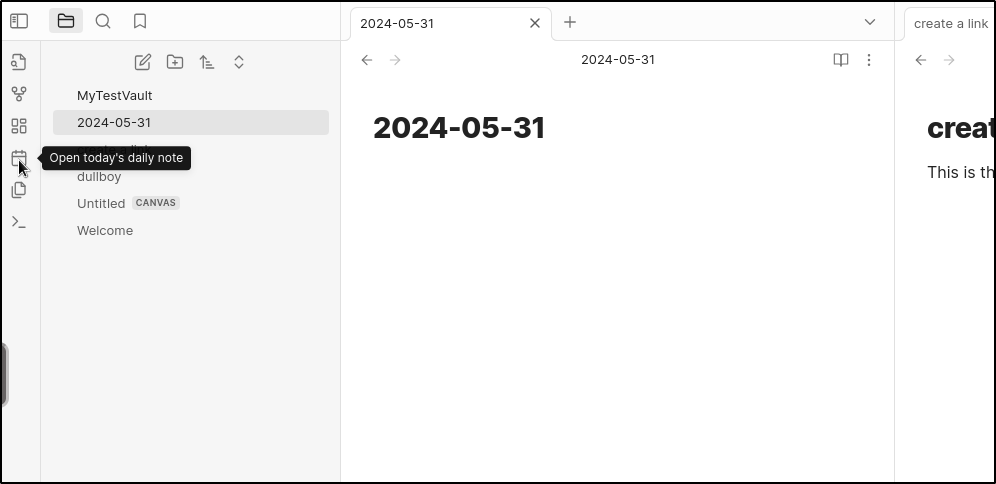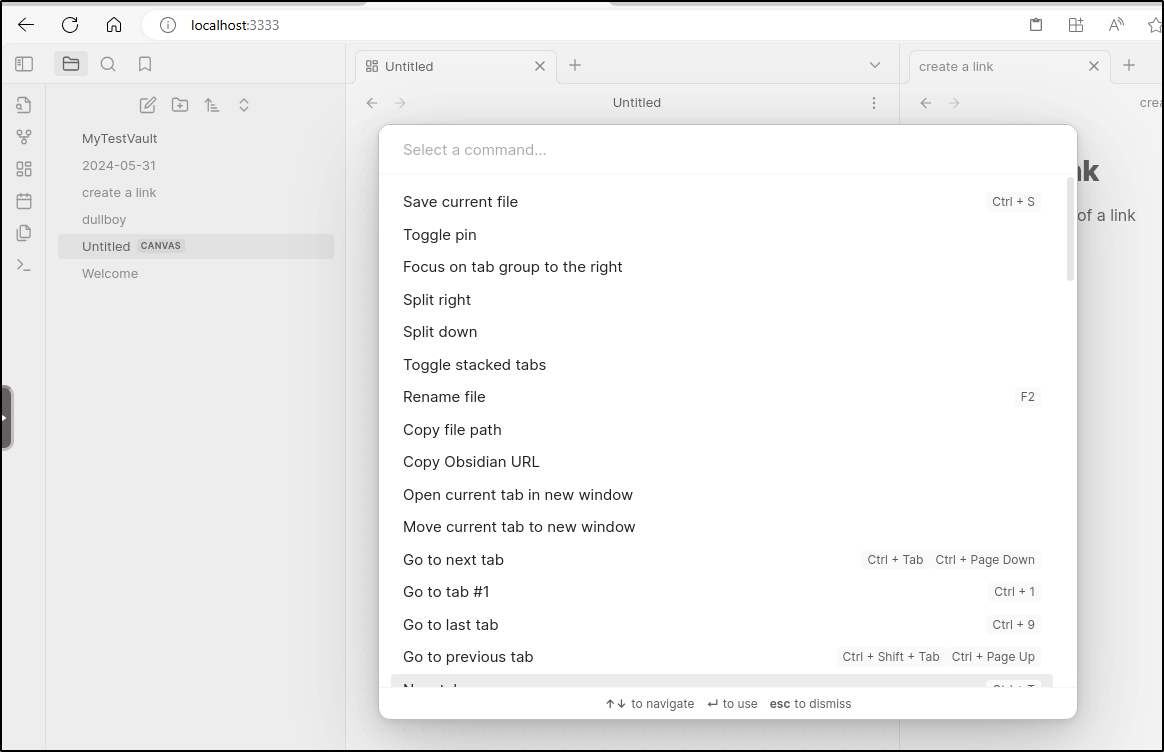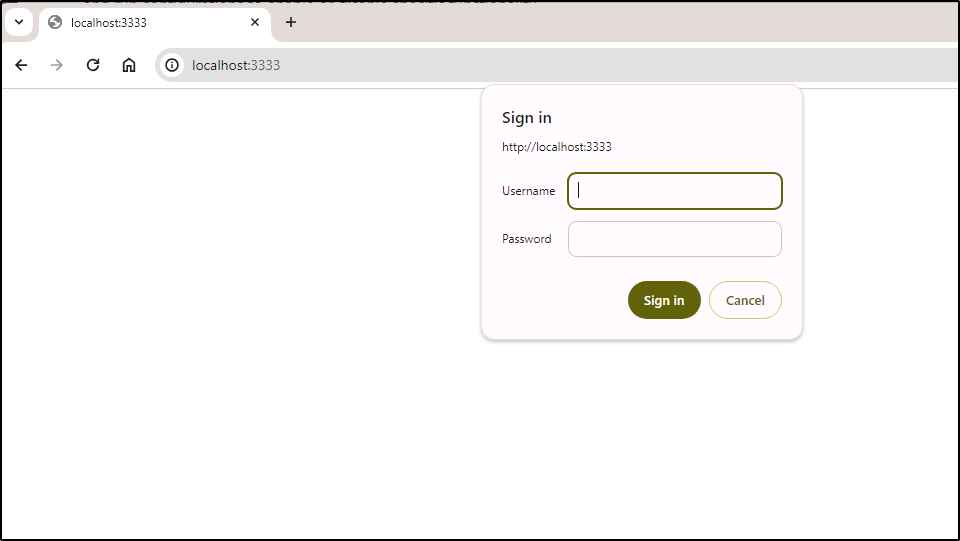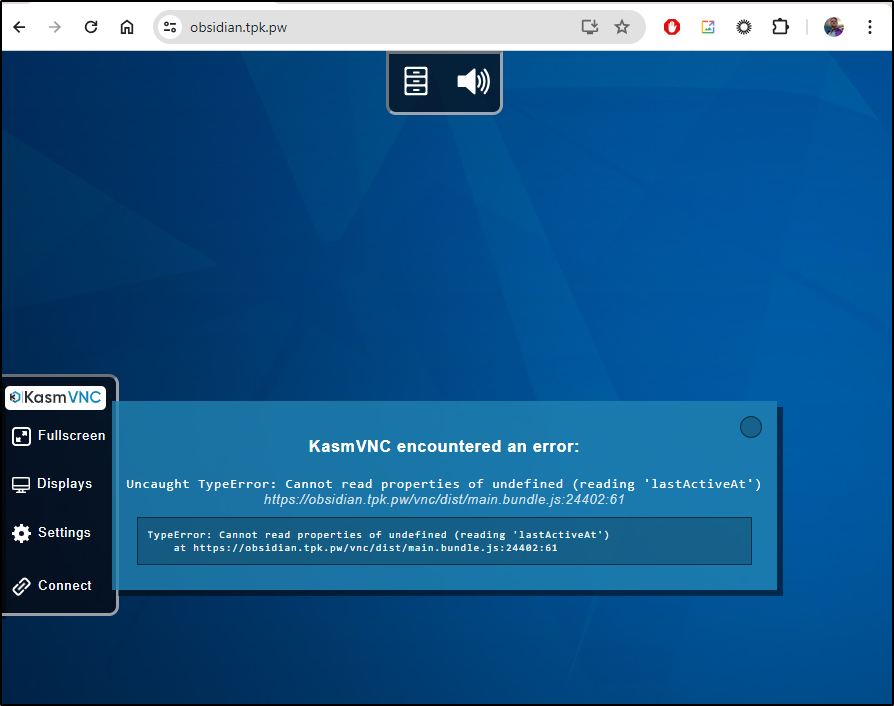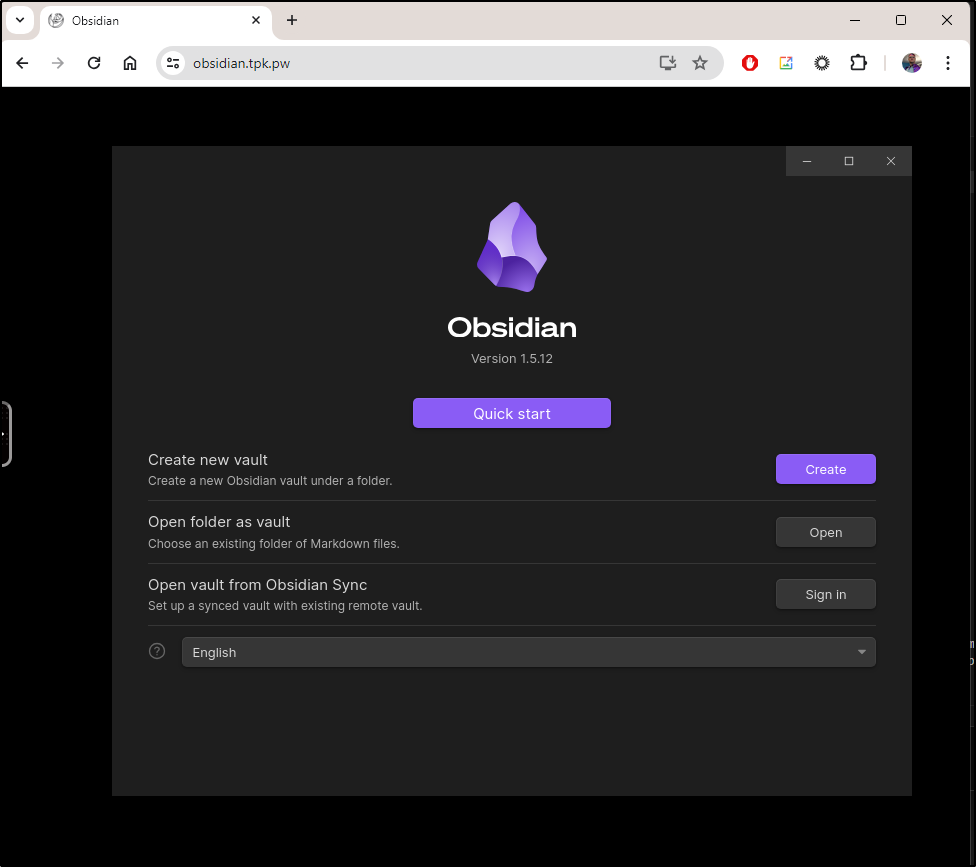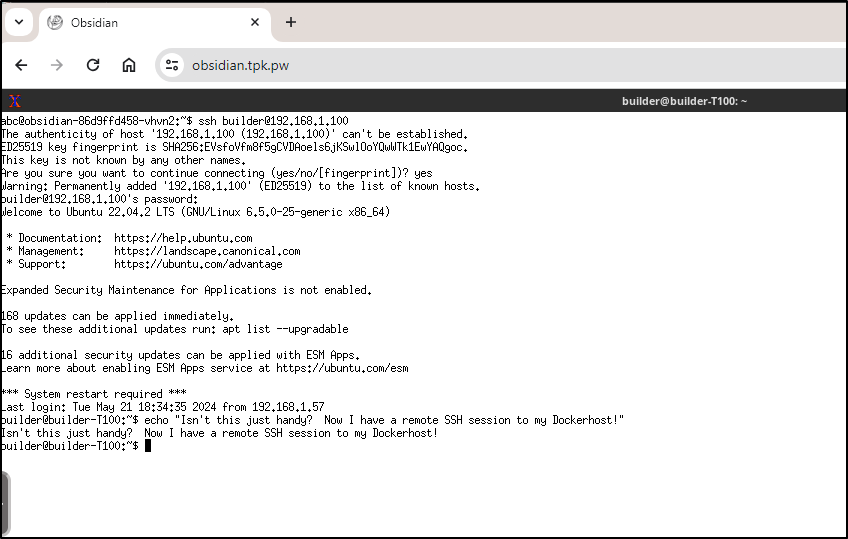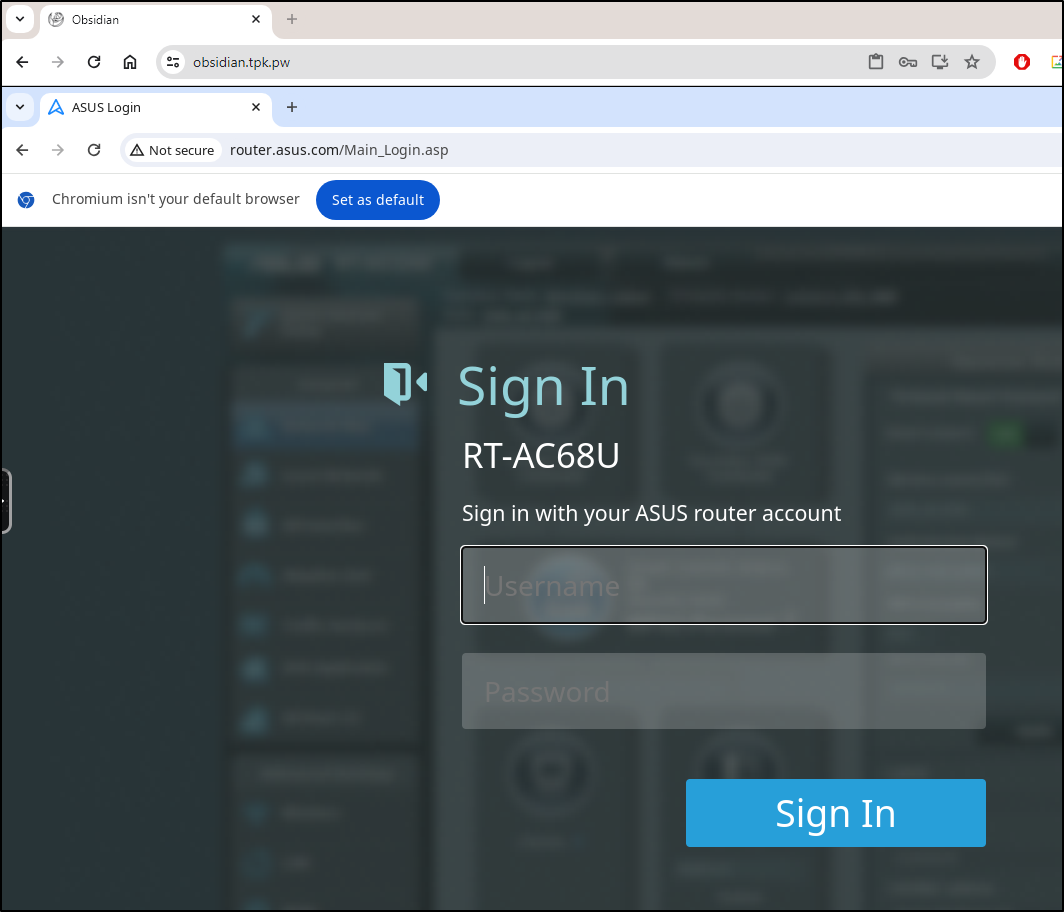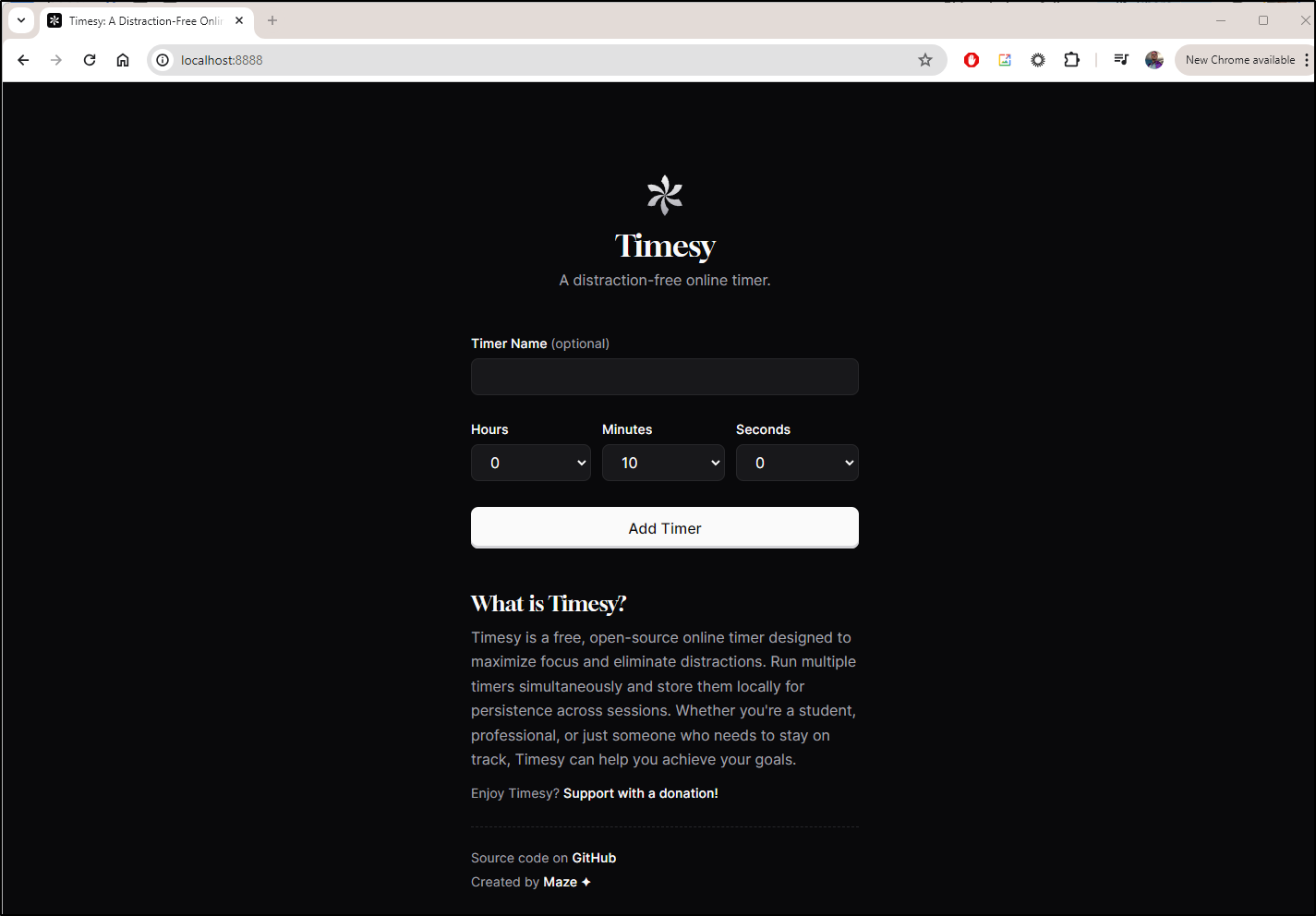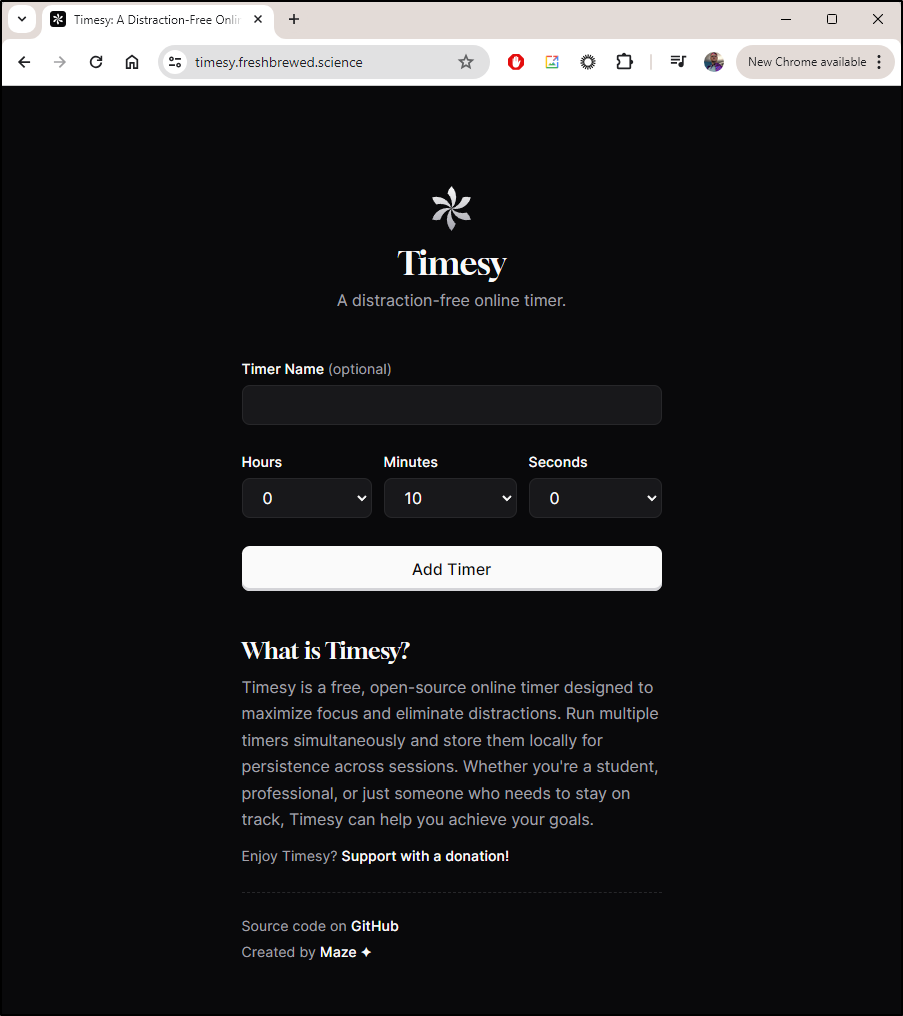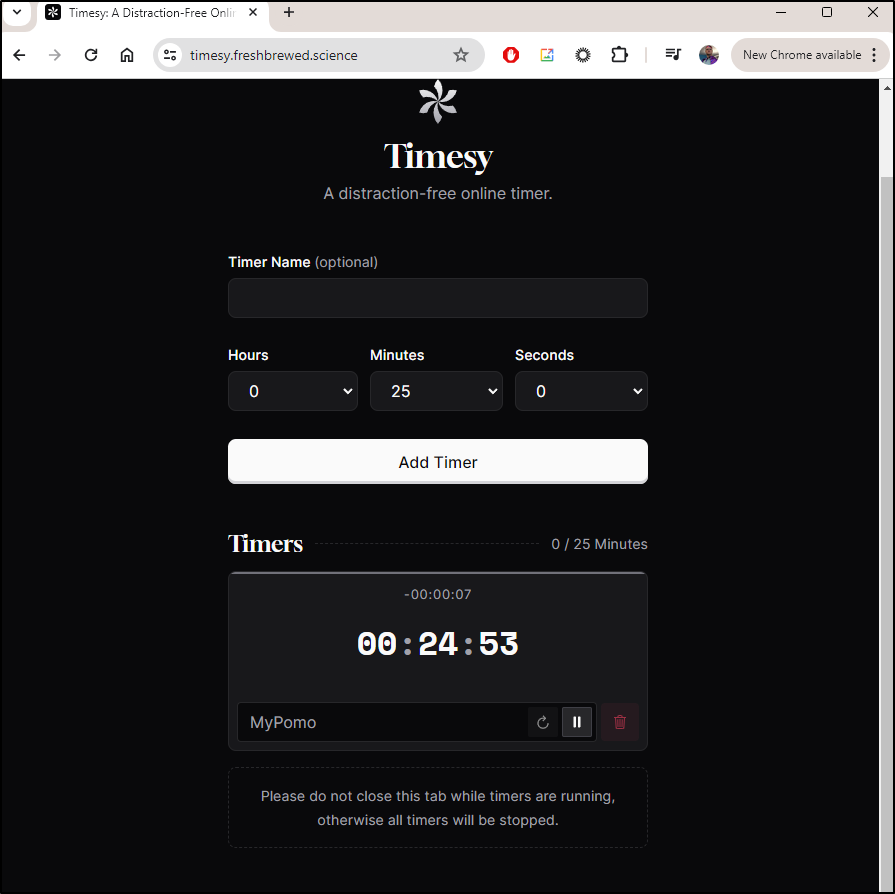Published: Jun 13, 2024 by Isaac Johnson
I had a couple bookmarked apps I wanted to explore. The first being Obsidian which I became aware of from a this MariusHosting post. The second is Timesy which I also saw in my feed from another MariusHosting post.
Obsidian is a note-taking app akin to Trillium which we explored in April or Siyuan which we looked at as well.
Timesy is just a simple timer app, akin to some of the timer apps we looked at in March.
We’ll work to launch both in Kubernetes and expose with TLS. I’ll use AWS Route53 for one and Azure DNS for the other.
Let’s dig in!
Obsidian
Obsidian is a note-taking app from Linuxserver who brought us Codeserver and Darktable.
In their docs, they suggest firing it up in Docker
docker run -d \
--name=obsidian \
--security-opt seccomp=unconfined `#optional` \
-e PUID=1000 \
-e PGID=1000 \
-e TZ=Etc/UTC \
-p 3000:3000 \
-p 3001:3001 \
-v /path/to/config:/config \
--device /dev/dri:/dev/dri `#optional` \
--shm-size="1gb" \
--restart unless-stopped \
lscr.io/linuxserver/obsidian:latest
I’ll create the rough equivelant in Kubernetes
# Persistent Volume Claim
apiVersion: v1
kind: PersistentVolumeClaim
metadata:
name: obsidian-config-pvc
spec:
accessModes:
- ReadWriteOnce
resources:
requests:
storage: 1Gi
---
# Deployment
apiVersion: apps/v1
kind: Deployment
metadata:
name: obsidian
spec:
replicas: 1
selector:
matchLabels:
app: obsidian
template:
metadata:
labels:
app: obsidian
spec:
containers:
- name: obsidian
image: lscr.io/linuxserver/obsidian:latest
env:
- name: PUID
value: "1000"
- name: PGID
value: "1000"
- name: TZ
value: "Etc/UTC"
volumeMounts:
- name: config-volume
mountPath: /config
ports:
- containerPort: 3000
name: http
resources:
requests:
memory: "250Mi"
limits:
memory: "1Gi"
restartPolicy: Always # Adjust based on your needs (unless-stopped, Always)
volumes:
- name: config-volume
persistentVolumeClaim:
claimName: obsidian-config-pvc
---
# Service
apiVersion: v1
kind: Service
metadata:
name: obsidian
spec:
selector:
app: obsidian
ports:
- port: 3000
targetPort: 3000
protocol: TCP
name: http
type: ClusterIP
and apply it
$ kubectl apply -f ./obsidian.yaml
persistentvolumeclaim/obsidian-config-pvc unchanged
deployment.apps/obsidian created
service/obsidian unchanged
I can then port-forward to test
$ kubectl port-forward svc/obsidian 3333:3000
Forwarding from 127.0.0.1:3333 -> 3000
Forwarding from [::1]:3333 -> 3000
I can then create a new local vault
I now have the first page in the vault setup. Just a simple welcome page
Here we can see adding links, tables and editing in general:
There are a few handy shortcuts like a “daily note”
and a command palette
I can exec into the pod and see, like the other linuxserver apps, it’s ust a desktop VM with VNC. The config is stored in the user home directory
$ kubectl exec -it obsidian-67f5484bd9-ff7b4 -- /bin/bash
root@obsidian-67f5484bd9-ff7b4:/# ls -ltra /config
total 48
drwxr-xr-x 1 root root 4096 May 30 23:52 ..
drwxr-xr-x 2 abc abc 4096 May 30 23:52 ssl
-rw-r--r-- 1 abc abc 37 May 30 23:52 .bashrc
drwx------ 3 abc abc 4096 May 30 23:52 .dbus
drwxr-xr-x 2 abc abc 4096 May 30 23:52 .fontconfig
drwx------ 3 abc abc 4096 May 30 23:52 .pki
drwxr-xr-x 5 abc abc 4096 May 30 23:52 .cache
drwxr-xr-x 4 abc abc 4096 May 30 23:55 .local
drwxr-xr-x 6 abc abc 4096 May 30 23:55 .config
drwxr-xr-x 4 abc abc 4096 May 30 23:55 .XDG
drwxrwxrwx 11 abc abc 4096 May 30 23:56 .
drwxr-xr-x 3 abc abc 4096 May 31 00:05 MyTestVault
root@obsidian-67f5484bd9-ff7b4:/# du -chs /config/MyTestVault/
52K /config/MyTestVault/
52K total
I believe I can add a custom user and password to enable some kind of basic auth
$ cat obsidian.yaml
# Persistent Volume Claim
apiVersion: v1
kind: PersistentVolumeClaim
metadata:
name: obsidian-config-pvc
spec:
accessModes:
- ReadWriteOnce
resources:
requests:
storage: 1Gi
---
# Deployment
apiVersion: apps/v1
kind: Deployment
metadata:
name: obsidian
spec:
replicas: 1
selector:
matchLabels:
app: obsidian
template:
metadata:
labels:
app: obsidian
spec:
containers:
- name: obsidian
image: lscr.io/linuxserver/obsidian:latest
env:
- name: PUID
value: "1000"
- name: PGID
value: "1000"
- name: TZ
value: "Etc/UTC"
- name: CUSTOM_USER
value: "builder"
- name: PASSWORD
value: "asdfasdf"
volumeMounts:
- name: config-volume
mountPath: /config
ports:
- containerPort: 3000
name: http
resources:
requests:
memory: "250Mi"
limits:
memory: "1Gi"
restartPolicy: Always # Adjust based on your needs (unless-stopped, Always)
volumes:
- name: config-volume
persistentVolumeClaim:
claimName: obsidian-config-pvc
---
# Service
apiVersion: v1
kind: Service
metadata:
name: obsidian
spec:
selector:
app: obsidian
ports:
- port: 3000
targetPort: 3000
protocol: TCP
name: http
type: ClusterIP
and apply to update
$ kubectl apply -f ./obsidian.yaml
persistentvolumeclaim/obsidian-config-pvc unchanged
deployment.apps/obsidian configured
service/obsidian unchanged
Let’s see if basic auth survives HTTPS ingress (usually its limited to HTTP)
I’ll create an A record
$ az account set --subscription "Pay-As-You-Go" && az network dns record-set a add-record -g idjdnsrg -z tpk.pw -a 75.73.224.240 -n obsidian
{
"ARecords": [
{
"ipv4Address": "75.73.224.240"
}
],
"TTL": 3600,
"etag": "390f3c1d-d23d-40eb-96e5-ecbeded90ae9",
"fqdn": "obsidian.tpk.pw.",
"id": "/subscriptions/d955c0ba-13dc-44cf-a29a-8fed74cbb22d/resourceGroups/idjdnsrg/providers/Microsoft.Network/dnszones/tpk.pw/A/obsidian",
"name": "obsidian",
"provisioningState": "Succeeded",
"resourceGroup": "idjdnsrg",
"targetResource": {},
"trafficManagementProfile": {},
"type": "Microsoft.Network/dnszones/A"
}
I’ll need to redeploy in my primary cluster as thus far this has just been in test
$ kubectl apply -f ./obsidian.yaml
persistentvolumeclaim/obsidian-config-pvc created
deployment.apps/obsidian created
service/obsidian created
Then I’ll apply an ingress
$ cat obsidian.ingress.yaml
apiVersion: networking.k8s.io/v1
kind: Ingress
metadata:
annotations:
cert-manager.io/cluster-issuer: azuredns-tpkpw
ingress.kubernetes.io/ssl-redirect: "true"
kubernetes.io/ingress.class: nginx
kubernetes.io/tls-acme: "true"
nginx.ingress.kubernetes.io/ssl-redirect: "true"
name: obsidian-ingress
spec:
rules:
- host: obsidian.tpk.pw
http:
paths:
- backend:
service:
name: obsidian
port:
number: 3000
path: /
pathType: Prefix
tls:
- hosts:
- obsidian.tpk.pw
secretName: obsidian-tls
$ kubectl apply -f ./obsidian.ingress.yaml
ingress.networking.k8s.io/obsidian-ingress created
When I saw the cert applied
$ kubectl get cert obsidian-tls
NAME READY SECRET AGE
obsidian-tls True obsidian-tls 2m4s
But I get a crash when I log in
The errors in the log show this is a websocket app
[ls.io-init] done.
Obt-Message: Xinerama extension is not present on the server
2024-05-31 00:25:01,333 [INFO] websocket 0: got client connection from 127.0.0.1
2024-05-31 00:25:01,333 [INFO] websocket 0: /websockify request failed websocket checks, not a GET request, or missing Upgrade header
2024-05-31 00:25:01,333 [INFO] websocket 0: 127.0.0.1 198.176.160.161 - "GET /websockify HTTP/1.1" 404 180
2024-05-31 00:25:45,154 [INFO] websocket 1: got client connection from 127.0.0.1
2024-05-31 00:25:45,154 [INFO] websocket 1: /websockify request failed websocket checks, not a GET request, or missing Upgrade header
2024-05-31 00:25:45,155 [INFO] websocket 1: 127.0.0.1 198.176.160.161 - "GET /websockify HTTP/1.1" 404 180
I’ll add the “websocket” annotation
apiVersion: networking.k8s.io/v1
kind: Ingress
metadata:
annotations:
cert-manager.io/cluster-issuer: azuredns-tpkpw
ingress.kubernetes.io/ssl-redirect: "true"
kubernetes.io/ingress.class: nginx
kubernetes.io/tls-acme: "true"
nginx.ingress.kubernetes.io/ssl-redirect: "true"
nginx.org/websocket-services: obsidian
name: obsidian-ingress
spec:
rules:
- host: obsidian.tpk.pw
http:
paths:
- backend:
service:
name: obsidian
port:
number: 3000
path: /
pathType: Prefix
tls:
- hosts:
- obsidian.tpk.pw
secretName: obsidian-tls
Then apply
builder@LuiGi:~/Workspaces/miscapps-06$ kubectl delete -f obsidian.ingress.yaml
ingress.networking.k8s.io "obsidian-ingress" deleted
builder@LuiGi:~/Workspaces/miscapps-06$ kubectl apply -f ./obsidian.ingress.yaml
ingress.networking.k8s.io/obsidian-ingress created
which works
If we forget our password, we can also fetch it from Kubernetes
$ kubectl get deployments obsidian -o json | jq '.spec.template.spec.containers[] | .env[] | select(.name == "CUSTOM_USER") | .value'
"builder"
$ kubectl get deployments obsidian -o json | jq '.spec.template.spec.containers[] | .env[] | select(.name == "PASSWORD") | .value'
"asdfasdfasdf"
As we can see below, we can easily use it for notes, but one can also just kill the app and launch a local browser and/or a local xterm to be a remote shell:
XTerm shell:
The browser is even handier - I now have an easy way to manage my router which has a web interface, but is restricted to local traffic
If it isn’t clear how I launch the Obsidian app or the Chromium/Xterm, it’s just a “right click” in the middle of the screen to bring up the pop-up launcher menu
Timsy
Another app I bookmarked from a MariusHosting blog was Timesy.
The Marius article suggests using docker compose:
version: "3.9"
services:
timesy:
container_name: Timesy
image: ghcr.io/remvze/timesy:latest
shm_size: 5g
security_opt:
- no-new-privileges:false
ports:
- 3439:8080
restart: on-failure:5
Let’s try and make that into a basic kubernetes manifest
$ cat timsy.yaml
apiVersion: apps/v1
kind: Deployment
metadata:
name: timesy-deployment
spec:
replicas: 1
selector:
matchLabels:
app: timesy
template:
metadata:
labels:
app: timesy
spec:
containers:
- name: timesy
image: ghcr.io/remvze/timesy:latest
ports:
- containerPort: 8080
---
apiVersion: v1
kind: Service
metadata:
name: timesy-service
spec:
selector:
app: timesy
ports:
- protocol: TCP
port: 80
targetPort: 8080
type: ClusterIP
we can then apply
$ kubectl apply -f ./timsy.yaml
deployment.apps/timesy-deployment created
service/timesy-service created
I’ll port-forward
$ kubectl port-forward svc/timesy-service 8888:80
Forwarding from 127.0.0.1:8888 -> 8080
Forwarding from [::1]:8888 -> 8080
Handling connection for 8888
Handling connection for 8888
And see it running without issue
Let’s skip right to routing traffic.
I’ll use AWS Route53 this time
$ cat r53-timesy.json
{
"Comment": "CREATE timesy fb.s A record ",
"Changes": [
{
"Action": "CREATE",
"ResourceRecordSet": {
"Name": "timesy.freshbrewed.science",
"Type": "A",
"TTL": 300,
"ResourceRecords": [
{
"Value": "75.73.224.240"
}
]
}
}
]
}
$ aws route53 change-resource-record-sets --hosted-zone-id Z39E8QFU0F9PZP --change-batch file://r53-t
imesy.json
{
"ChangeInfo": {
"Id": "/change/C07953101QG3ZGV6NULX8",
"Status": "PENDING",
"SubmittedAt": "2024-05-31T11:17:28.562Z",
"Comment": "CREATE timesy fb.s A record "
}
}
Even though I doubt it uses Websocket, I’ll leave in the annotation on the Ingress defintion
$ cat timesy.ingress.yaml
apiVersion: networking.k8s.io/v1
kind: Ingress
metadata:
annotations:
cert-manager.io/cluster-issuer: letsencrypt-prod
ingress.kubernetes.io/ssl-redirect: "true"
kubernetes.io/ingress.class: nginx
kubernetes.io/tls-acme: "true"
nginx.ingress.kubernetes.io/ssl-redirect: "true"
nginx.org/websocket-services: timesy-service
name: timesy
spec:
rules:
- host: timesy.freshbrewed.science
http:
paths:
- backend:
service:
name: timesy-service
port:
number: 80
path: /
pathType: ImplementationSpecific
tls:
- hosts:
- timesy.freshbrewed.science
secretName: timesy-tls
Like before, I’ll watch for the cert to get satisified
$ kubectl get cert timesy-tls
NAME READY SECRET AGE
timesy-tls False timesy-tls 36s
$ kubectl get cert timesy-tls
NAME READY SECRET AGE
timesy-tls False timesy-tls 86s
$ kubectl get cert timesy-tls
NAME READY SECRET AGE
timesy-tls True timesy-tls 110s
We can now hit Timesy on https://timesy.freshbrewed.science
I can add a Pomodoro timer
I now have a timer I can run and reset
I can confirm it persists between browser launches, but using a new browser provider or incognito resets it
I don’t capture audio in ShareX, when it reaches zero it lets out a loud high pitch watch/alarm clock sound with 4 repeating pulses, then stops.
Summary
We started with Obsidian from the LinuxServer Group and tested it locally before exposing it externally. We added password authentication and learned how we can use the VNC box for a general-purpose jump box as well.
We then launched Timsy into the cluster and exposed it with TLS/Ingress. We tested a few timers and while I didn’t show it above, Timesy worked just as well on a mobile interface.
I hope you found one or both of those apps useful. Here are the links (albeit the Obsidian is password restricted)


